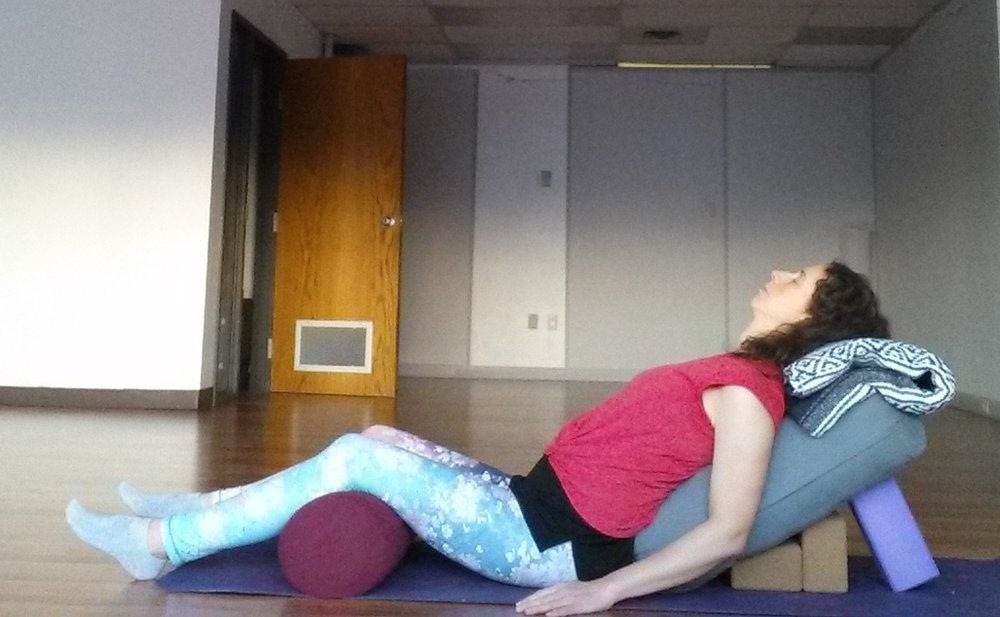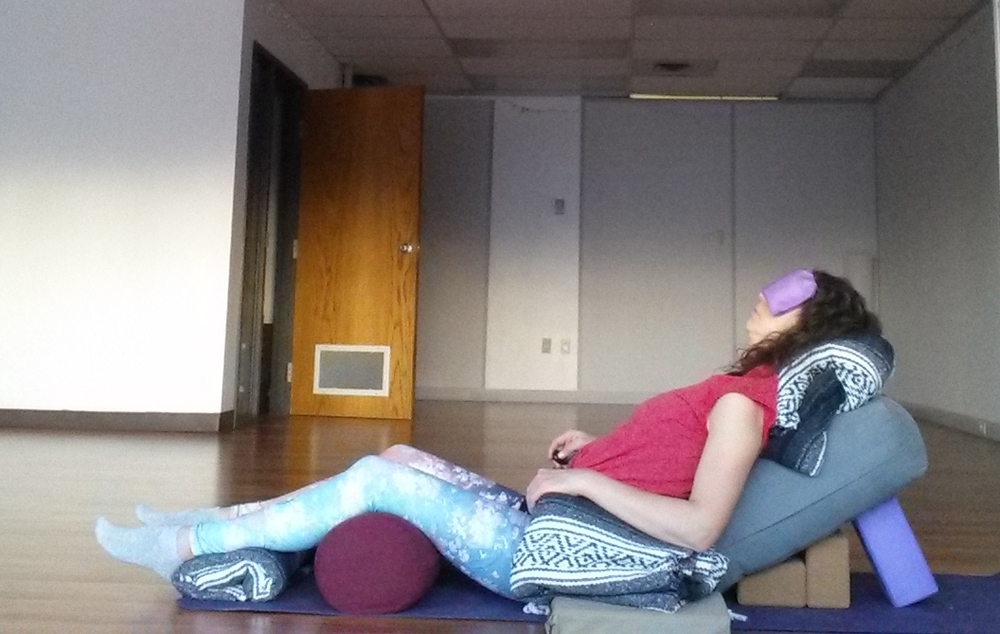Although I’ve been teaching Restorative yoga for many years, in recent years, through studying with Judith Lasater, I’ve gained a much deeper appreciation for the Art & Science behind creating a Restorative yoga practice. Judith has been teaching for nearly 50 years, has written several books on yoga and is credited with popularizing Restorative yoga, which she learned by studying directly with its creator, BKS Iyengar. I recently had the opportunity to return to Judith’s teacher training, this time as an assistant. Judith explains how every subtle detail of the prop arrangement, the way a particular person’s body arranges itself in the pose, and the environment of the room plays a role in facilitating the experience of deep relaxation that can stimulate healing. And the proof is in the profound experience of the practice when guided in this way.
Judith explains that Restorative yoga is “the use of props to support the body in positions of comfort and ease in order to facilitate health and relaxation.” It is not a practice about experiencing your edge in a stretch and in fact, we precisely don’t want to feel the stretch in Restorative as stretching still involves the muscles being active and the goal in Restorative is to let go of muscular effort in order to reach the physiological state of relaxation.
In our society taking time for relaxation is counter-cultural. I’ve written more about the Culture of Busy here. We are a society of Do-ers, always Do-ing, rarely taking any time for reflection, non-doing, or simply Be-ing. While our society doesn’t tend to prioritize time for relaxation, our biology actually requires it for us to maintain good health.
Our sympathetic nervous system, sometimes referenced as being responsible for the “fight or flight or freeze” response, is responsible for keeping us alert and active during daily activities and is also responsible for quickly bringing us to an alert and ready state (to fight or escape) when we are faced with situations we perceive as threats. This is our stress response and these days we frequently are activating it for non-life-threatening situations we perceive as stressful. This perceived stress causes heightened activity in the sympathetic nervous system, and if this heightened activity is prolonged through continual stress, it can lead to undesirable impacts for blood pressure, immune function, digestion, sleep cycles, anxiety, depression, chronic pain, and even gene expression (through epigenetics). Don’t get me wrong; we need our sympathetic nervous system. We need to be alert when driving, solving complicated problems, and a whole array of other important responsibilities. In cardiovascular sports it is also the sympathetic nervous system that is dominant.
However, we have this whole other part of our nervous system called the parasympathetic nervous system. It controls actions necessary for tissue regeneration (growth and repair), digestion, and reproduction. It maintains homeostasis. While the sympathetic nervous system when activated will cause the heart rate to increase, blood pressure to go up, and breathing rate to increase, the exact opposite happens when the parasympathetic nervous system is activated. They kind of inhibit each other. So when we live a life of Go, Go, Go, or Do, Do, Do, we may be spending the majority of our time in sympathetic dominance, and this can have long-term consequences on our overall health.
Enter Relaxation. Ahhhhhh. Take a moment to pause here and just let the feeling of that word sink in. Relaxation.
Finding relaxation is the ticket to activating the parasympathetic response and practicing relaxation regularly can help you switch back to parasympathetic dominance more quickly after being in a more alert state.
Savasana or Corpse pose at the end of any yoga class is the opportunity to relax and activate the parasympathetic nervous system. Many people dislike Savasana, feel that it is a waste of time, or find that they have trouble letting go in it. Sometimes there is significant mental resistance to the idea of taking 10-20 minutes to relax. Restorative yoga has tricks to help with that.
In Restorative yoga we use the props to manipulate the nervous system. To basically set up the body in such a way that the nervous system can’t help but relax (switch to parasympathetic dominance). Even the most relax-averse person can experience that state when set up well. And once someone has really experienced that deep relaxation and the peace of mind and calm it brings, they usually don’t need convincing to want to try it again. That is the magic of Restorative yoga. And that is why the details matter. There is an art and a science to it.
Can you sense the difference between this photo

and this one?

In both photos I’ve set myself up with the basic set up for Supported Reclining Pose that you might be instructed to set up in a Restorative class. But in the bottom photo my neck is not in hyperextension, my head is supported well, and I have more support under my elbows and ankles. With this additional support I’m better able to let go of muscular effort release more deeply. I’m more likely to access that feeling of “ahhh.”
That “ahhh” feeling is what we are going for in Restorative yoga. Paying special attention to the support for the head and neck, to the places where the body meets or doesn’t meet the props, to create a rhythm to the way the body is placed in the position, to the light and temperature of the room – these things all matter if we want to manipulate the nervous system and experience deep relaxation.
The benefits of regular relaxation practice and restoring parasympathetic dominance include decreases in hypertension, improvements in sleep and immune and digestive function, decreased symptoms of chronic pain, decreased feelings of depression and anxiety, and benefits to our overall health. Isn’t this something we all could use more of?
If you are interested in trying out or going deeper with your Restorative yoga practice you may want to try out my upcoming Workshop on Restorative Yoga or my Private Therapeutic Restorative Yoga package where you receive a private Restorative session followed by 4 small group classes with a lot of individualized attention. You can also find all of my current Events here.


